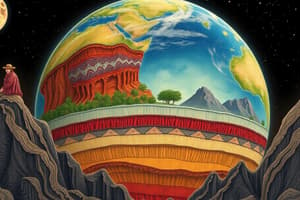Podcast
Questions and Answers
What is the approximate thickness of the lithosphere?
What is the approximate thickness of the lithosphere?
- 60 kilometers
- 120 kilometers
- 80 kilometers (correct)
- 100 kilometers
Which element constitutes the highest percentage in the Earth's crust?
Which element constitutes the highest percentage in the Earth's crust?
- Oxygen (correct)
- Silicon
- Iron
- Aluminum
Where is the Mohorovicic Discontinuity typically located beneath the ocean basin?
Where is the Mohorovicic Discontinuity typically located beneath the ocean basin?
- 10 kilometers
- 5 kilometers
- 15 kilometers
- 8 kilometers (correct)
What defines the Mohorovicic Discontinuity?
What defines the Mohorovicic Discontinuity?
At what average depth can the Mohorovicic Discontinuity be found beneath the continents?
At what average depth can the Mohorovicic Discontinuity be found beneath the continents?
What is the primary composition of the continental crust?
What is the primary composition of the continental crust?
What defines the Mohorovicic Discontinuity?
What defines the Mohorovicic Discontinuity?
Which statement about oceanic crust is true?
Which statement about oceanic crust is true?
Which materials primarily make up the outer core?
Which materials primarily make up the outer core?
What is the main characteristic of the lithosphere?
What is the main characteristic of the lithosphere?
Who discovered the Mohorovicic Discontinuity?
Who discovered the Mohorovicic Discontinuity?
What was the main goal of Project Mohole?
What was the main goal of Project Mohole?
What is the depth reached by the Russian Kola Borehole?
What is the depth reached by the Russian Kola Borehole?
What is the primary composition of the Earth's mantle?
What is the primary composition of the Earth's mantle?
Which institution was involved in returning core samples from the ocean floor?
Which institution was involved in returning core samples from the ocean floor?
What is the asthenosphere in relation to the mantle?
What is the asthenosphere in relation to the mantle?
What significant achievement is associated with the Japanese deep sea drilling vessel Chikyu?
What significant achievement is associated with the Japanese deep sea drilling vessel Chikyu?
At what depth did Project Mohole cease operations?
At what depth did Project Mohole cease operations?
What is the primary component of the upper mantle known as 'Crofesima'?
What is the primary component of the upper mantle known as 'Crofesima'?
At what depth does the Gutenberg Discontinuity occur?
At what depth does the Gutenberg Discontinuity occur?
Which elements are primarily found in the lower mantle, referred to as 'Nifesima'?
Which elements are primarily found in the lower mantle, referred to as 'Nifesima'?
What is the state of rocks in the mesosphere of the mantle?
What is the state of rocks in the mesosphere of the mantle?
Which of the following elements is NOT a primary component of the Earth's mantle composition?
Which of the following elements is NOT a primary component of the Earth's mantle composition?
Which layer of the Earth is the densest and hottest?
Which layer of the Earth is the densest and hottest?
What temperature characteristic is notable about the inner core?
What temperature characteristic is notable about the inner core?
What are the main substances found in the outer core of the Earth?
What are the main substances found in the outer core of the Earth?
Flashcards are hidden until you start studying
Study Notes
Crust
- The crust is the outermost layer of the Earth, composed mainly of two types of rock: granite (continental crust) and basalt (oceanic crust).
- Continental crust has an average thickness of 30 to 70 kilometers, while oceanic crust ranges from 6 to 12 kilometers.
- Continental crust is primarily made of silica and aluminum, referred to as 'Sial', whereas oceanic crust consists mainly of silica and magnesium, known as 'Sima'.
- The density of continental crust is approximately 2.6 to 2.7 g/cm³, compared to oceanic crust which is denser at about 2.8 to 3.0 g/cm³.
- The lithosphere, consisting of the crust and the upper mantle, is broken into tectonic plates.
Mohorovicic Discontinuity (Moho)
- The Mohorovicic Discontinuity marks the boundary between the crust and the mantle.
- Average depth of the Moho is about 8 kilometers beneath ocean basins and approximately 32 kilometers beneath continents.
- Discovered in 1909 by Croatian seismologist Andrija Mohorovicic.
- Project Mohole aimed to reach the Moho but was abandoned in 1966 after drilling 183 meters.
- Significant research includes the Kola Borehole, reaching 12,260 meters deep in 1989, and the Japanese vessel Chikyu, which drills into sub-oceanic regions.
Mantle
- The mantle is the thickest layer of the Earth, located beneath the crust, comprising about half of the Earth's mass and made of hot, dense, semi-solid rock.
- The asthenosphere, a fluid layer within the mantle, facilitates convection currents that cause lithospheric plate movement.
- The upper mantle contains elements like chromium, iron, silicon, and magnesium ('Crofesima').
- The mesosphere is the lower part of the mantle, where rocks remain solid despite extreme heat.
- The lower mantle, the densest and hottest layer, is composed of nickel, iron, silicon, and magnesium ('Nifesima').
Core
- The Earth's core is the innermost layer divided into the outer and inner core.
- The outer core is a fluid layer primarily composed of chromium and iron, termed 'Crofe'.
- The inner core is a solid sphere with a radius of about 1,216 kilometers and temperatures comparable to the Sun's surface.
Discontinuities
- Gutenberg Discontinuity occurs at a depth of approximately 2,900 kilometers below the Earth's surface, separating the mantle from the core.
Studying That Suits You
Use AI to generate personalized quizzes and flashcards to suit your learning preferences.




